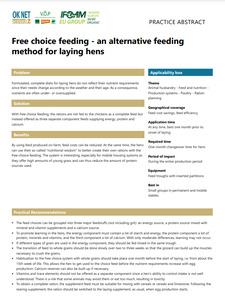{Tool} Free choice feeding - an alternative feeding method for laying hens (OK-Net EcoFeed Practice Abstract). [Fütterung nach freier Wahl - eine alternative Fütterungsmethode für Legehennen.] Creator(s): Müsseler, Olivia and Vogt-Kaute, Werner. Issuing Organisation(s): Öko-Beratungsgesellschaft. OK-Net EcoFeed Practice Abstract, no. 038. (2020)
|
PDF
- English
(Free choice feeding - an alternative feeding method for laying hens)
137kB | |
|
PDF
- German/Deutsch
(Fütterung nach freier Wahl - eine alternative Fütterungsmethode für Legehennen)
138kB | |
![[thumbnail of 2022-08-01 16_50_14-PA_00038443_L0.pdf.png]](/38443/5.hassmallThumbnailVersion/2022-08-01%2016_50_14-PA_00038443_L0.pdf.png)  Preview |
Image (PNG)
- Cover Image
- English
86kB |
Document available online at: https://orgprints.org/38443
Summary in the original language of the document
By using feed produced on-farm, feed costs can be reduced. At the same time, the hens can use their so-called "nutritional wisdom" to better create their own rations with the free-choice feeding. The system is interesting, especially for mobile housing systems as they offer high amounts of young grass and can thus reduce the amount of protein sources used.
Practical recommendations: 1) The feed choices can be grouped into three major feedstuffs (not including grit): an energy source, a pro-tein source mixed with mineral and vitamin supplements and a calcium source. 2) To promote learning in the hens, the energy component must contain a lot of starch and energy, the pro-tein component a lot of protein, minerals and vitamins, and the third component a lot of calcium. With only moderate differences, learning may not occur. 3) If different types of grain are used in the energy component, they should be fed mixed in the same trough. 4) The transition of feed to whole grains should be done slowly over two to three weeks so that the gizzard can build up the muscles necessary to crush the grains. 5) Habituation to the free choice system with whole grains should take place one month before the start of laying, i.e. from about the 15th week of life. This allows the hen to get used to the choice feed before the nutrient requirements increase with egg production. Calcium reserves can also be built up if necessary. 6) Vitamins and trace elements should not be offered as a separate component since a hen’s ability to control intake is not well understood. There is a risk that some animals may avoid them or eat too much, resulting in toxicity. 7) To obtain a complete ration, the supplement feed must be suitable for mixing with cereals or cereals and limestone. Following the rearing supplement, the ration should be switched to the laying supplement, as usual, when egg production starts. 8) A sufficient animal/feeding area ratio must be maintained, and there must be enough distance between the troughs. For example, for every 100 hens, two hanging troughs per feed component.
| EPrint Type: | Practice tool |
|---|---|
| What problem does the tool address?: | Formulated, complete diets for laying hens do not reflect their nutrient requirements since their needs change according to the weather and their age. As a consequence, nutrients are often under- or oversupplied. |
| What solution does the tool offer?: | With free choice feeding, the rations are not fed to the chickens as a complete feed but instead offered as three separate component feeds supplying energy, protein and calcium. |
| Country: | Germany |
| Type of Practice Tool: | Practice abstracts |
| Keywords: | animal husbandry, layer chickens, feeding, rations |
| Agrovoc keywords: | Language Value URI English layer chickens http://aims.fao.org/aos/agrovoc/c_12109 English animal husbandry http://aims.fao.org/aos/agrovoc/c_8532 English feeding http://aims.fao.org/aos/agrovoc/c_2838 English rations http://aims.fao.org/aos/agrovoc/c_6461 |
| Subjects: | Animal husbandry > Feeding and growth Animal husbandry > Production systems > Poultry |
| Research affiliation: | European Union > Horizon 2020 > OK-Net EcoFeed European Union > Horizon 2020 > OK-Net EcoFeed > OK-Net Ecofeed Tools Germany > Naturland European Union > Organic Farm Knowledge |
| Horizon Europe or H2020 Grant Agreement Number: | 773911 |
| Related Links: | https://organic-farmknowledge.org/tool/38443 |
| Project ID: | ofk |
| Deposited By: | Forschungsinstitut für biologischen Landbau, FiBL |
| ID Code: | 38443 |
| Deposited On: | 30 Sep 2020 07:11 |
| Last Modified: | 02 May 2024 10:32 |
| Document Language: | English, German/Deutsch |
| Status: | Published |
Repository Staff Only: item control page

 Download Statistics
Download Statistics Download Statistics
Download Statistics
